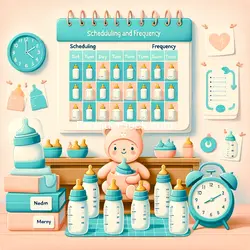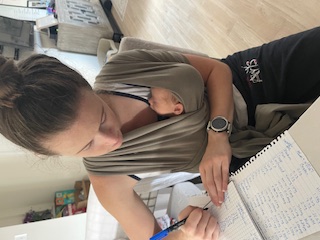
Navigating the World of Bottle Feeding: Scheduling and Frequency
Understanding Your Baby's Needs
Babies are unique, and their feeding needs can vary. Babies must eat more frequently than older kids and adults, who eat three meals daily. Here's a general guide to help you understand how often your baby might need feeding based on age.
For Newborns
In the early weeks, newborns typically need to be fed about every 2-3 hours or 8-12 times in 24 hours. They have tiny tummies and digest formula more slowly than breast milk, so they get hungry often!
1-2 Months Old
Around this age, your baby's stomach has grown, and they can handle more formula in one sitting. They might eat every 4-5 hours, giving you a more predictable schedule.
6-12 Months Old
When you introduce solid foods around 6 months, your baby's formula needs will gradually decrease. However, formula or breast milk is still their primary source of nutrition, so they'll likely need bottle feedings 4-5 times a day.
How Much Should My Baby Eat?
Figuring out how much to feed your baby can be a puzzle. A good rule of thumb is to offer about 2.5 ounces of formula per pound of body weight daily. For example, a 10-pound baby might need about 25 ounces of formula in 24 hours. As your baby grows, they'll let you know if they need more!
Tips for Setting a Feeding Schedule
- Watch for Hunger Cues: Instead of watching the clock, look for signs that your baby is hungry. This can help you create a flexible schedule that suits their needs.
- Be Flexible: Your baby's appetite can change from day to day. They might be hungrier during growth spurts or less hungry when feeling unwell.
- Create a Routine: While flexibility is important, having a general routine can help your baby feel secure and make your life easier.
Adjusting the Schedule
As your baby gets older, their feeding schedule will naturally change. When you start introducing solid foods, you'll begin to adjust the amount of formula they need. It's all about balancing and gradually shifting to more solids and fewer bottles.
Final Thoughts
Setting a feeding schedule for your baby doesn't have to be stressful. By paying attention to your baby's cues, you can develop a routine that works for both of you. Remember, there's no one-size-fits-all schedule, so don't worry if your baby's routine looks different from someone else's. You've got this, and your baby is lucky to have you guiding them through this journey. Happy feeding!
Related posts in this guide
- The Basics of Infant Formula: A Guide for New Parents
- Decoding Infant Formula: Types, Brands, and How to Choose
- Getting Ready for Bottle Feeding: A Simple Guide for Parents
- How to Safely Prepare Infant Formula: A Step-by-Step Guide
- Mastering Bottle Feeding: Techniques and Positions for Happy Babies
- Understanding Baby's Hunger: A Guide to Feeding Cues
- Navigating the World of Bottle Feeding: Scheduling and Frequency
- Keeping It Clean: The Ultimate Guide to Bottle Feeding Hygiene
- Smooth Moves: Transitioning Your Baby from Formula to Solid Foods
- Navigating Baby Feeding Challenges: A Parent's Guide to Common Concerns



